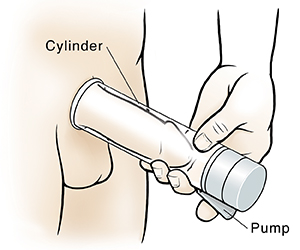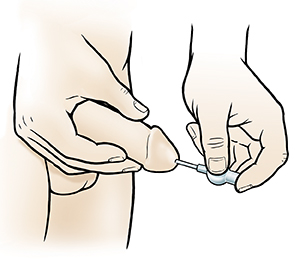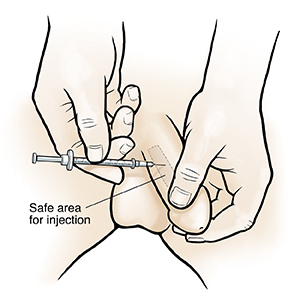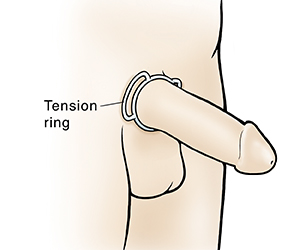Erectile Dysfunction
Erectile Dysfunction (Impotence)
What is erectile dysfunction?
Erectile dysfunction (ED) or impotence means you can’t get an erection. It can also mean you aren't happy with the size or hardness of your erections, or how long your erections last.
In the past, ED was thought to be due to psychological problems. It is now known that, for most men, ED is caused by physical problems. These are most often related to the blood supply of the penis.
What causes erectile dysfunction?
There are different types and causes of ED. These are some of the most common:
Premature ejaculation. This is the inability to keep an erection long enough for mutual pleasure due to climaxing too soon.
Performance anxiety. This is most often caused by stress.
Depression. Being depressed can affect your ability to get an erection. Some antidepressants cause erection problems, too.
Organic impotence. This involves the arteries or veins in the penis. It is the most common cause of ED, especially in older men. It can be related to hardening of the arteries throughout the body. Injury or a venous leak in the penis may also cause ED.
Diabetes. ED is common in men with diabetes. It causes early and severe hardening of the arteries. Problems with the nerves controlling erections are also often seen in men with diabetes.
Nervous system causes. Several nervous system problems can lead to ED. These include multiple sclerosis, stroke, and spinal cord and nerve injuries. Nerve damage from pelvic surgeries can cause ED.
Medicine-induced impotence. Blood pressure medicines, anti-anxiety and antidepressant medicines, glaucoma eye drops, and cancer chemotherapy medicines are just some of the many medicines that can cause ED.
Hormone-induced impotence. Hormone abnormalities can cause ED. These include increased prolactin, a hormone made by the pituitary gland. They also include steroid abuse by bodybuilders, too much or too little thyroid hormone, and hormones used to treat prostate cancer. Low testosterone can also cause ED.
Low testosterone. Low testosterone can be linked to ED.
Lifestyle choices. Smoking, excessive alcohol use, being overweight, and not exercising can also lead to ED.
Who is at risk for erectile dysfunction?
ED is a symptom that is linked to many health problems such as:
Prostate problems
Type 2 diabetes
The testicles are not making hormones the way they should (hypogonadism)
High blood pressure
Vascular disease and vascular surgery
Heart disease or heart failure
High cholesterol
Low levels of HDL (high-density lipoprotein)
Nervous system disorders
Curvature of the penis (Peyronie disease)
Depression, stress, or anxiety
Alcohol use
Relationship problems
Many long-term (chronic) diseases, especially kidney failure and dialysis
Smoking, which worsens the effects of other risk factors, such as vascular disease or high blood pressure
What are the symptoms of erectile dysfunction?
The symptom of ED is not being able to get or keep an erection firm enough for sex. ED can mean that you can’t get an erection at all. Or it can mean you can’t get an erection consistently, or can only get brief erections.
How is erectile dysfunction diagnosed?
Diagnosis of ED may include:
Review of health and sexual history. This may reveal conditions that lead to ED. It can also help your healthcare provider tell the difference between problems with erection, ejaculation, orgasm, or sexual desire.
Physical exam. To look for an underlying problem, such as:
A problem in the nervous system. This may be involved if your penis doesn't respond as expected to certain touching.
Secondary sex characteristics. Things such as hair pattern can point to hormone problems, which involve the endocrine system.
Abnormal features of the penis itself. These could suggest the cause of ED.
Lab tests. These can include blood counts, urine tests, a cholesterol test, and measurements of creatinine and liver enzymes. When low sexual desire is a symptom, checking testosterone in the blood can show problems with the endocrine system.
Penile ultrasound. This is used to measure the blood flow in the penis.
Psychosocial exam. This is done to help find psychological factors that may be affecting your performance. Your sexual partner may also be interviewed.
How is erectile dysfunction treated?
Treatment for ED is based on the cause of the problem. Some of the treatments that may be used include:
Lifestyle changes. These include cutting back on alcohol, quitting smoking, losing weight, and increasing physical activity.
Reviewing your medicines. You may need to cut back on or change those medicines that may be linked to ED.
Psychotherapy. This may be used to help decrease the stress and anxiety that may be linked to sex.
Prescription medicines taken by mouth (oral). These are often used to treat ED. There are many different medicines available.
Tell your healthcare provider about all the medicines you are taking. This includes over-the-counter and prescription medicines, vitamins, herbs, and supplements. The medicines used to treat ED can have dangerous interactions with some common medicines.
Men shouldn't take these medicines if they have a history of heart attack or stroke, or if they have a bleeding disorder or stomach ulcers.
Prescription medicines injected into the penis or put into the urethra. These are also available.
Testosterone therapy. This may improve energy and mood and increase sexual interest in older men who have low testosterone. It is not advised for men who have normal testosterone levels for their age. That is because there is a risk of prostate enlargement and other side effects.
Vacuum devices. These can be used to create an erection by using a partial vacuum to draw blood into the penis. Then an elastic ring is put on the base of the penis to keep the blood there during sex.
Penile implants. These can be surgically placed if other treatments do not work. The types of implants used to treat ED include:
Inflatable implants.A pump is put in the scrotum and two cylinders are placed in the erection chambers of the penis. The pump moves a saline solution into the cylinders to cause an erection. It also removes the solution to deflate the penis.
Malleable implants.Two semi-rigid but bendable rods are placed in the erection chambers of the penis. This lets the man bend his penis into an erect or nonerect position.
Living with erectile dysfunction
ED can cause strain on a couple. Many times, men won't get into sexual situations because they are embarrassed. In turn, their partner may feel rejected or inadequate. It's important to talk openly with your partner. Some couples may get treatment for ED together. Other men prefer to get treatment without their partner's knowledge. Not talking about it is the main barrier to getting treatment. The loss of erectile function can have a profound effect on a man. The good news is that ED can often be treated safely and effectively.
Feeling embarrassed about ED may prevent many men from getting the medical care they need. This can delay diagnosis and treatment of more serious underlying conditions. ED itself is often linked to an underlying problem such as heart disease, diabetes, liver disease, or other health conditions. Talk with your healthcare provider if you have problems with ED. Help is available.
Key points about erectile dysfunction
Erectile dysfunction (ED) or impotence means you can’t get an erection. It can also mean you aren't happy with the size or hardness of erections, or how long erections last.
There are many different types and causes of ED. Mental health problems, physical problems, certain diseases and health conditions, certain prescription medicines, and lifestyle choices have all been linked to ED.
Physical and psychological exams are a key part of diagnosing ED. Lab tests done on urine and blood may also be used.
ED can be treated. Treatments are based on the cause of the problem and can range from lifestyle changes to prescription medicines to penile implants.
ED can be a strain on a couple. Many times the man’s partner is included in the diagnosis and treatment of ED.
Next steps
Tips to help you get the most from a visit to your healthcare provider:
Know the reason for your visit and what you want to happen.
Before your visit, write down questions you want answered.
Bring someone with you to help you ask questions and remember what your provider tells you.
At the visit, write down the name of a new diagnosis and any new medicines, treatments, or tests. Also write down any new instructions your provider gives you.
Know why a new medicine or treatment is prescribed and how it will help you. Also know what the side effects are.
Ask if your condition can be treated in other ways.
Know why a test or procedure is recommended and what the results could mean.
Know what to expect if you do not take the medicine or have the test or procedure.
If you have a follow-up appointment, write down the date, time, and purpose for that visit.
Know how you can contact your provider if you have questions.
Understanding Erectile Dysfunction
Understanding Erectile Dysfunction
Erectile dysfunction (ED) is a problem getting an erection firm enough or keeping it long enough to have sex. The problem can happen to anyone with a penis at any age. But health problems that can lead to ED become more common with age. Up to half of people with a penis who are over age 40 have ED at some point.
Causes of ED
ED can have many causes. Most are physical. Some are emotional issues. Often, a combination of causes is involved. Causes of ED may include:
-
Health conditions such as diabetes, hardening of the arteries, high blood pressure, heart disease, chronic kidney disease, seizures, stroke, or depression
- Low testosterone
-
Smoking tobacco or marijuana
-
Drinking too much alcohol
-
Side effects from medicines
-
Injuries to nerves or blood vessels
-
Emotional issues, such as stress or relationship problems
ED can be treated

Prescription medicines for ED are available. These medicines often help. But depending on the cause of the ED, medicines may not be enough. In these cases, other treatment options are available. These include erectile aids and surgery. Talk with your healthcare provider about the treatments that are available and pick the one that's right for you. New treatments for ED are being studied. No matter what treatment you decide on, stay in touch with your healthcare provider. If your symptoms persist, your provider may be able to adjust your current treatment or try something new.
Erectile Aids and Other Treatments
Erectile Dysfunction: Erectile Aids and Other Treatments
If you have erectile dysfunction (ED), treatment can help. Certain treatments work directly on your penis. Talk with your healthcare provider about the pros and cons of each. And be sure to learn the correct method for the erectile aid you select.
Vacuum pump
-
You slip a tube over your penis. A simple pump then creates a vacuum that pulls blood into your penis. This causes an erection. You then put a tension ring around the base of your penis to hold in the blood. You then remove the tube. Don't keep the tension ring on for more than 30 minutes.
-
Risks and complications may include pain in your penis or scrotum. The penis may also feel cool or change color during your erection.

Transurethral medicine
-
You put the end of a small applicator into your urethra to place a tiny, soft medicine pellet. The medicine is absorbed into your penis. The medicine relaxes blood vessels. Then they can fill with blood. In about 10 minutes, your penis can be hard enough for sex. To keep your erection, you may need to use a tension ring.
-
Risks and complications may include pain and irritation of your urethra. Get medical help right away if you have an erection for more than 4 hours.

Self-injections
-
You inject a special medicine into your penis. The medicine relaxes blood vessels. Then they can fill with blood. In about 10 minutes, your penis can be hard enough for sex. A tension ring isn't needed to keep your erection. Your healthcare provider can explain the injection process to you.
-
Risks and complications may include pain, bleeding, bruising, or scarring. Get medical help right away if you have an erection for more than 4 hours.

Tension ring
-
A tension ring is often used along with another type of treatment. Once enough blood has flowed into your penis to cause an erection, the tension ring will stop the blood from flowing out again. This keeps the erection. Don't keep the ring on for more than 30 minutes. A tension ring is also called a constriction ring or venous flow controller.
-
Risks and complications may include pinched, bruised, or irritated skin. If you have an allergic reaction to latex rings, try a silicone ring.

Rebuilding Intimacy
Erectile Dysfunction: Rebuilding Intimacy
Being intimate means being close as a couple, with sex as just one part of intimacy. A hug, a kind remark, or a gift can be very romantic, even if sex doesn’t follow. So, renew your intimacy along with your sex life. Learn to talk with, and listen to, your partner. And remember that your value as a man goes beyond what you do in bed.

Tips for intimacy
As you and your partner become closer to each other, you might find that you can enjoy sex more.
-
Show and tell your partner what you like. If you don’t, your partner might not know what you want.
-
Ask your partner to show you how they want to be touched.
-
Be patient. Take your time. Relax. Give yourselves a chance to become aroused.
-
Try being intimate without sex. Instead, exchange back rubs. Or try kissing, or just a soft touch.
-
Focus on what you and your partner like about each other. This could be a certain laugh or smile, or other joys you share together.
Tips for talking
It’s OK to be shy when you talk about sex with your partner. But talking gets easier with practice. Use these tips when you talk with each other:
-
Choose a time and place when you’re both relaxed and comfortable.
-
Listen to your partner. Try repeating back what you think the other has said. This will help show if you’ve understood each other.
-
Don’t judge what your partner says. Talking feels safer if you don’t criticize each other.
-
Don’t be defensive. You may not like something your partner says. But you can still thank your partner for being honest.
-
Think about meeting with a counselor. They’re trained to help couples who are being treated for erectile dysfunction.